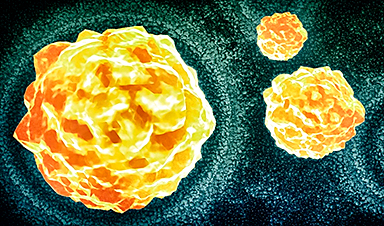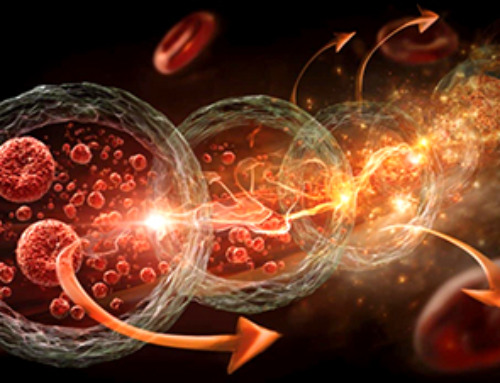In an article recently published in the journal Nanotechnology, researchers employed a single particle imaging method for fluorescence excitation with moderate intensity to achieve spatial resolution. Here, the semiconductor nanocrystals were accessed, whose emission lifetimes depended on excitation intensity.
Nanocrystals
The excited fluorophore’s de-excitation rate with optical modulation is an important tool to achieve super-resolution in microscopy techniques, including ground state depletion microscopy, stimulated emission depletion, or reversible saturable optical fluorescence transitions microscopy.
In organic dyes or fluorescent proteins, the excitation methods involve transition rate tailoring from a single excited to a ground state. However, semiconductor nanocrystals intrinsically possess multiple excited states, grey or charged states.
The excessive energy stored either in the nanocrystal core or trapped in the bulk of the nanocrystal or at its surface results in the origin of multiple states. Wavefunction overlap of an exciton with trapped charges can increase the non-radiative energy transfer probability from the exciton to the charge. Thus, the exciton’s excited-state lifetime decreases based on the location and amount of charge trapped within the particle.
Semiconductor Nanocrystals for Super-Resolution Imaging
In the present study, the researchers used the semiconductor nanocrystal’s excitation-intensity-dependent lifetime to increase the spatial imaging resolution beyond the diffraction limit. A single semiconductor nanocrystal was scanned through a confocal spot with a diffraction limit to modulate the excitation power density, which is maximum at the center and minimized towards the edges. Thus, several photo-generated excess charges in a particle can be modulated; consequently, its excited-state lifetime is also modulated.
The lifetime modulation relative to the position of a particle according to the focused laser allowed the enhancement of the spatial resolution in the scanned image of the nanocrystal. This was demonstrated by two close-by emitter images’ disentanglement, which remained unresolved in the intensity image. This method combined the simplicity and robustness of the measurement technique that combines the laser-scanning confocal microscope with fluorescence-lifetime measurement capability.
Research Findings
The researchers used cadmium selenium (CdSe) /cadmium sulfur (CdS) / thick-shell quantum dots (QDs); the shell thickness helped reduce fluorescence blinking. A transmission electron microscopy (TEM) image showed that the average particle size is in the range of 18 ± 2 nanometers, which included a CdS shell consisting of approximately 15 atomic layers. In this type of giant QDs, the interaction between excited-state carriers and surface trap states was weakened, further suppressing the non-radiative Auger recombination. Fluorescence blinking was suppressed by reducing the Auger efficiency and hot-carrier capture. If not suppressed, blinking could lead to patchy single-particle confocal scan images, which reduce the particle’s localization accuracy.
The radially polarized laser beam was used to scan semiconductor nanocrystals with the diffraction-limited focal spot. Herein, the radial polarization majorly led to axially polarized excitation of the approximate diameter of 180 nanometers at a wavelength of 640 nanometers. This enhanced the diffraction-limited resolution by approximately 1.4 times compared to a linearly polarized Gaussian beam.
Multichannel picosecond event timer-equipped confocal microscope was used for all fluorescence measurements, allowing fluorescence lifetime imaging. To focus the excitation light and collect the fluorescence light, a high numerical aperture objective was equipped for the system. As an excitation source, a white-light laser system with an acousto-optical tunable filter was used. A non-polarizing beam splitter reflected the excitation light towards the objective. Calculations for average excited state lifetime were performed by fitting the fluorescence decay curves with a multi-exponential decay model.
The characteristic intensity pattern, shown from the single quantum emitter’s recorded scan image depended on the orientation of the dipole moment of fluorophore’s excitation. However, the three-dimensional (3D) excitation isotropy of spherical semiconductor nanocrystals avoided the dependency of the excitation pattern on the orientation.
The semiconductor nanocrystal’s fluorescence lifetime that depended on the excitation power allowed the narrowing of the particle’s fluorescence lifetime image compared to the diffraction-limited intensity image.
The non-additivity of lifetimes depended on sigmoid curve steepness at its inflection point and the number of detected photons determining the fluorescence decay curve fitting quality. Further, the non-additivity of lifetimes resulted in the resolution enhancement. However, both curve steepness and photons quantity depended on the experimental conditions, including QD’s optical properties and microscope parameters.
Conclusion
In conclusion, the researchers presented the proof-of-principle measurements for semiconductor nanocrystal excitation-intensity-dependent, lifetime modulation-based, super-resolution imaging method. They showed that this method allowed to achieve a ten times resolution at moderate fluorescence intensities, which further could be enhanced by more photons collection.
This method employed a conventional fluorescence-lifetime confocal microscope based on semiconductor nanocrystal’s fluorescence lifetime imaging to access a broad fluorescence microscopy community. Although the present work involved the excitation by using a radially polarized laser beam, a linearly polarized Gaussian beam can also be used for excitation with minimized focus diameter.
News
AI matches doctors in mapping lung tumors for radiation therapy
In radiation therapy, precision can save lives. Oncologists must carefully map the size and location of a tumor before delivering high-dose radiation to destroy cancer cells while sparing healthy tissue. But this process, called [...]
Scientists Finally “See” Key Protein That Controls Inflammation
Researchers used advanced microscopy to uncover important protein structures. For the first time, two important protein structures in the human body are being visualized, thanks in part to cutting-edge technology at the University of [...]
AI tool detects 9 types of dementia from a single brain scan
Mayo Clinic researchers have developed a new artificial intelligence (AI) tool that helps clinicians identify brain activity patterns linked to nine types of dementia, including Alzheimer's disease, using a single, widely available scan—a transformative [...]
Is plastic packaging putting more than just food on your plate?
New research reveals that common food packaging and utensils can shed microscopic plastics into our food, prompting urgent calls for stricter testing and updated regulations to protect public health. Beyond microplastics: The analysis intentionally [...]
Aging Spreads Through the Bloodstream
Summary: New research reveals that aging isn’t just a local cellular process—it can spread throughout the body via the bloodstream. A redox-sensitive protein called ReHMGB1, secreted by senescent cells, was found to trigger aging features [...]
AI and nanomedicine find rare biomarkers for prostrate cancer and atherosclerosis
Imagine a stadium packed with 75,000 fans, all wearing green and white jerseys—except one person in a solid green shirt. Finding that person would be tough. That's how hard it is for scientists to [...]
Are Pesticides Breeding the Next Pandemic? Experts Warn of Fungal Superbugs
Fungicides used in agriculture have been linked to an increase in resistance to antifungal drugs in both humans and animals. Fungal infections are on the rise, and two UC Davis infectious disease experts, Dr. George Thompson [...]
Scientists Crack the 500-Million-Year-Old Code That Controls Your Immune System
A collaborative team from Penn Medicine and Penn Engineering has uncovered the mathematical principles behind a 500-million-year-old protein network that determines whether foreign materials are recognized as friend or foe. How does your body [...]
Team discovers how tiny parts of cells stay organized, new insights for blocking cancer growth
A team of international researchers led by scientists at City of Hope provides the most thorough account yet of an elusive target for cancer treatment. Published in Science Advances, the study suggests a complex signaling [...]
Nanomaterials in Ophthalmology: A Review
Eye diseases are becoming more common. In 2020, over 250 million people had mild vision problems, and 295 million experienced moderate to severe ocular conditions. In response, researchers are turning to nanotechnology and nanomaterials—tools that are transforming [...]
Natural Plant Extract Removes up to 90% of Microplastics From Water
Researchers found that natural polymers derived from okra and fenugreek are highly effective at removing microplastics from water. The same sticky substances that make okra slimy and give fenugreek its gel-like texture could help [...]
Instant coffee may damage your eyes, genetic study finds
A new genetic study shows that just one extra cup of instant coffee a day could significantly increase your risk of developing dry AMD, shedding fresh light on how our daily beverage choices may [...]
Nanoneedle patch offers painless alternative to traditional cancer biopsies
A patch containing tens of millions of microscopic nanoneedles could soon replace traditional biopsies, scientists have found. The patch offers a painless and less invasive alternative for millions of patients worldwide who undergo biopsies [...]
Small antibodies provide broad protection against SARS coronaviruses
Scientists have discovered a unique class of small antibodies that are strongly protective against a wide range of SARS coronaviruses, including SARS-CoV-1 and numerous early and recent SARS-CoV-2 variants. The unique antibodies target an [...]
Controlling This One Molecule Could Halt Alzheimer’s in Its Tracks
New research identifies the immune molecule STING as a driver of brain damage in Alzheimer’s. A new approach to Alzheimer’s disease has led to an exciting discovery that could help stop the devastating cognitive decline [...]
Cyborg tadpoles are helping us learn how brain development starts
How does our brain, which is capable of generating complex thoughts, actions and even self-reflection, grow out of essentially nothing? An experiment in tadpoles, in which an electronic implant was incorporated into a precursor [...]





















